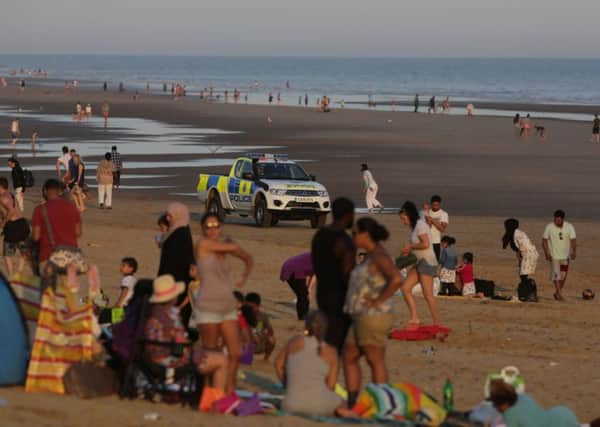Swallowed by the sea: Is it time taxpayers funded lifesaving on our beaches?


AS the sun glistened off the seemingly benign waters on a baking hot day at the beach, the North Sea couldn’t have looked more inviting.
Pestered off my towel by a young son desperate to try out his new bodyboard – a short length of foam which allows the waves to carry the surfer toward the shore – we waded into the shallows together.
Advertisement
Hide AdAdvertisement
Hide AdSuddenly, without warning, the waves started to get stronger. Just as I was giving serious thought to returning to the sand, one crashed against my body and knocked my son clean off his feet, the undertow dragging him further into the water.


Thankfully, we were still on the shoreline and he was able, with a little help, to get back to his feet. I told him we would retreat to the beach and wait until the sea grew calmer.
Dealing with a disappointed five-year-old was, I told myself, far preferable to risking calamity if we stayed where we were.
And this, sadly, has been a summer that has once again brought home the perils of playing in the sea. The deaths of five friends at Camber Sands in East Sussex was a painful reminder of the capricious nature of the waters that surround our small island.
Advertisement
Hide AdAdvertisement
Hide AdThe five, who included two brothers, were dragged away by a vicious rip tide on the hottest day of the year.


On a day trip from London, their ignorance of the local conditions was undoubtedly a factor in the tragedy. But then how many of us could claim to have an in-depth knowledge of the vagaries of a particular stretch of open water? Would we know how to spot a rip tide, let alone survive one?
“No two locations are the same when it comes to conditions,” says Kenny MacDermid, national drowning prevention co-ordinator with the Royal Life Saving Society. “No body of water is like any other and each has its own risk, its own tides.
“Then there are other factors to consider, such as how strong a swimmer an individual is and their general health. Every time we go into the water we should ask ourselves, ‘Am I really prepared for what it might throw at me?’”
Advertisement
Hide AdAdvertisement
Hide AdThis weekend the long summer holidays finally draw to a close. But they have already proved costly.
Along with the five who died at Camber Sands, the seas have claimed a mother and her six-year-old son off the coast of Aberdeen, a windsurfer at Essex, and a swimmer in his 50s in Dorset. Two-year-old Mckayla Bruynius and her father Rudy died after being hit by a large wave which swept them into the sea at Newquay in Cornwall. And that’s just the toll from the last 10 days.
Of course, without the heroic crews of the Royal National Lifeboat Institution it could have been much worse. Only the other evening two teenage brothers were rescued from the sea after getting into difficulties while swimming at Skinningrove in North Yorkshire.
Thankfully, luck was on their side. They were spotted by a trainee lifeboat crew member who happened to be walking on the pier and raised the alarm. As I write this, a search operation is under way to find a 17-year-old off the coast of Roker Beach at Sunderland.
Advertisement
Hide AdAdvertisement
Hide AdThe recent spate of deaths during the recent hot spell has reignited the debate as to whether there are sufficient levels of protection on Britain’s beaches.
The stretch of coast where my son and I entered the water was not patrolled by lifeguards. There were distinctive red and yellow flags planted further along the beach showing where those on duty were monitoring but as this small area was already crowded with families we decided to go elsewhere, knowing we would not be venturing too far into the water, unlike a number of youngsters we saw nearby.
At Camber Sands there were no permanent lifeguards on duty on the day of the five drownings, despite 25,000 people being on the beach. It has led the family of one of the boys to call for more protection.
“A five minute delay caused this death toll,” said Ajirthan Ravi, whose brother Nitharsan drowned. “I recommend there to be a reliable lifeguard. A lifeguard could have saved their lives.”
Advertisement
Hide AdAdvertisement
Hide AdBut is it really possible to keep watch over endless miles of coastline? Not least when so often we’re dependent on volunteers to save lives?
Many lifeguards give up their free time for nothing, even though they know full well that they may be called upon to enter dangerous waters in order to rescue a missing child or swimmer in trouble. If you think of it like that, it becomes a preposterous notion.
Our lives and those of our loved ones are in the hands of people, mostly youngsters, who while being proficient swimmers and well trained, are acting on a purely voluntary basis.
The RNLI maintains paid patrols at more than 200 beaches, where guards must be competent swimmers over the age 16 and are paid around £8 to £10 an hour.
Advertisement
Hide AdAdvertisement
Hide AdOf course, the RNLI itself depends on voluntary contributions to stay afloat, the complete absence of Government funding meaning that it must rely on legacies, cake sales and tin rattling. For an emergency service, isn’t that rather terrifying?
Accentuating the positives, Clare Hopps, a spokeswoman for RNLI North, says that independence was one of the lifeboat services “core principles” and meant it was free of Government interference. “Being independent means we can delpoy our funds where and when they are needed. We are very lucky in that we have such a wide cross section of people raising money for us.”
Yet there must be the concern that when demand is greatest, that money will only stretch so far.
“There’s no question that rescuing people from the sea is an emergency service,” says Kenny MacDermid of the Royal Life Saving Society. “Drowning is one of the leading causes of death in children and we’ve got to do something about it.
Advertisement
Hide AdAdvertisement
Hide Ad“Government support would enable us to expand our impact whether in terms of lifeguard training and recruitment or prevention work.”
The UK strategy launched this year sets the ambitious target of reducing drownings by 50 per cent by 2026.
“It gives us a real target. The more Government support the better in terms of helping to reach that figure.”
A great deal of educational work is being done in schools by charities such as the RLSS and RNLI. In Scarborough, funds raised in memory of local man Andrew McGeown, who died last year after jumping into the sea to rescue his dog, are being spent on sea swimming training for children.
Advertisement
Hide AdAdvertisement
Hide AdSuch education and simple common sense have a sizeable role to play in keeping us safe when we venture into the sea. Prevention is better than cure.
But there is a sense too that more lives could be saved if the presence of lifeguards and others was determined by need, rather than cost.
The thousands in danger each year
Two out of three people in the UK head to the seaside at least once a year. Around 7,000 of them get into serious difficulties.
In a typical year, around 400 people accidentally drown in UK waters. The numbers spike during the summer months.
Advertisement
Hide AdAdvertisement
Hide AdRNLI lifeguards patrol 200 beaches around the country. Last year they assisted 751 people in Yorkshire and responded to 17,050 incidents countrywide, aiding a total of 19,353 people.
The new UK national drowning prevention strategy, launched by Scarborough and Whitby MP Robert Goodwill, aims to halve the number of deaths by drowning by 2026.
It costs around £460,000 a day to run the RNLI, all of which is donated by the public.